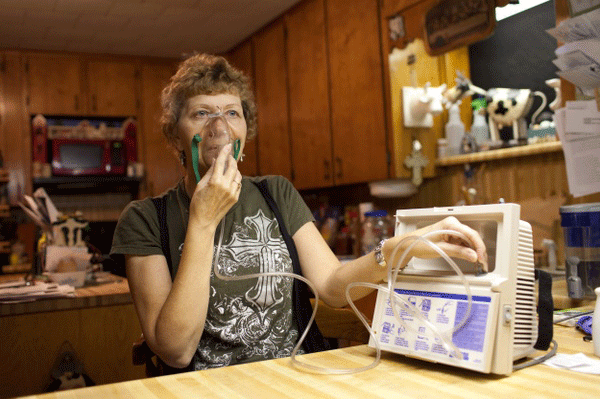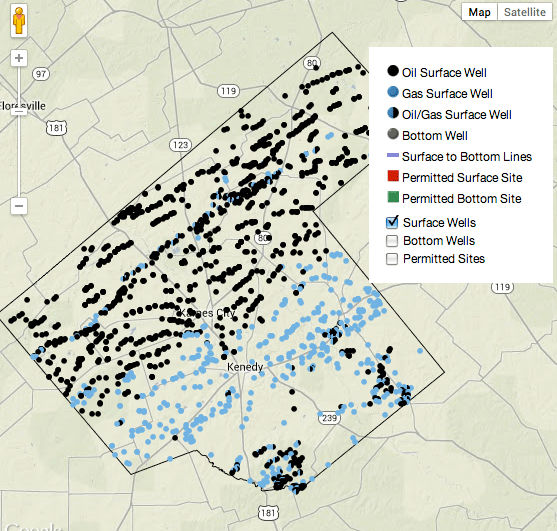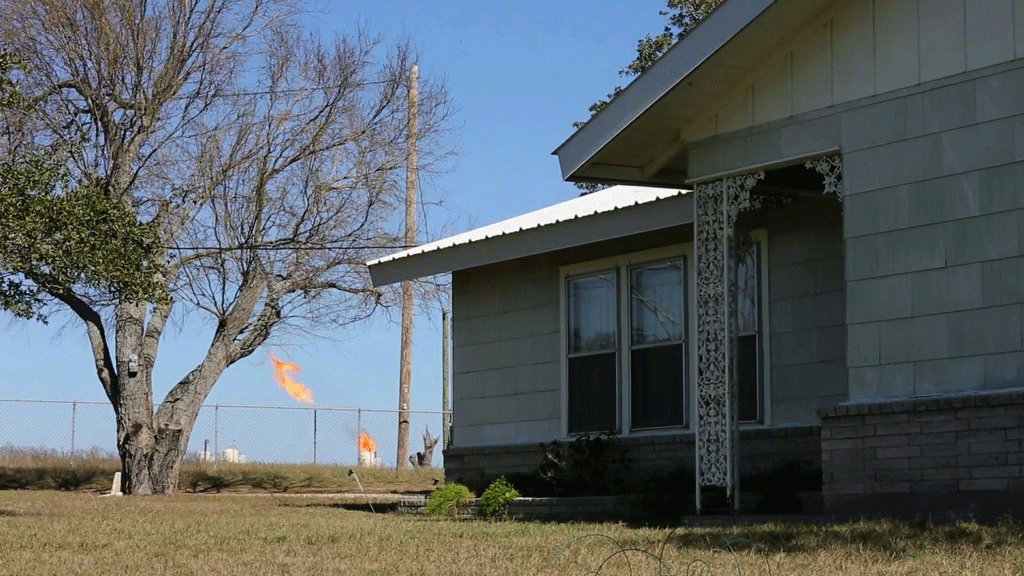Bad Air inTexas from Fracking Boom
Air Date: Week of February 28, 2014

Lynn Buehring with the machine she needs for breathing. (Lance Rosenfield/ Prime)
Nearly 8,000 oil and gas wells have been drilled into the Eagle Ford shale in Texas in the last 5+ years. Area residents say their health has suffered as the air has become polluted with toxic chemicals. Inside Climate News, the Weather Channel and the Center for Public Integrity conducted a 8 month investigation that found Texas regulators are largely ignoring these air pollution problems. Jim Morris is a senior reporter for the Center and co-author of the story. He tells host Steve Curwood that Eagle Ford is twice the size of Massachusetts but has just 5 permanent air quality monitoring locations.
Transcript
CURWOOD: From the Jennifer and Ted Stanley Studios in Boston, this is Living on Earth. I’m Steve Curwood. The fracking boom for natural gas and oil has created an abundance of domestic energy, but it can also lead to an abundance of air pollution if it’s not appropriately regulated. And judging by the number of complaints, nowhere is fracking air pollution more of a problem, than atop the Eagle Ford Shale in South West Texas . An eight-month investigation by Inside Climate News, the Weather Channel and the Center for Public Integrity has found many people in the region developed serious health problems after fracking began.
WOMAN1: For myself I’ve experienced a lot of difficulty with my breathing.
MAN: I used to come out here to this very park before all that was there and run literally 4 or 5 miles a day without any problems. Now I can barely get a mile out before I start choking. There’s something heavier with the air here.
WOMAN2: I have 2.5 acres and I can’t bring my grandchild out here to enjoy it because I’m afraid for his health.
CURWOOD: Jim Morris is a senior reporter at the Center for Public Integrity who worked on the investigation.
MORRIS: The Eagle Ford Shale is a formation that is at the center of one of the biggest oil and gas booms in the country, probably the world. It currently has almost 8,000 wells that have been drilled in it, and another 5,000 or so that have been permitted that will be drilled. An industry person told us, it is the biggest economic development zone in the world right now.
CURWOOD: And this oil and gas wells we’re talking about now.
MORRIS: It’s oil and gas, yes.
CURWOOD: So, what are the types of chemicals, and how much of them are in the air as a result of all this drilling and fossil fuel extraction?
MORRIS: Some of the chemicals that go along with oil and gas drilling and processing include Volatile Organic Compounds, benzene, formaldehyde, toluene, zylene. This are chemicals that have been linked to cancer, they’ve been linked to neurological effects, birth defects that includes particulate matter and sulfur dioxide that can cause terrible respiratory problems. This part of the state has an added layer of risk. There’s a chemical there called hydrogen sulfide, which is a naturally occurring gas that is extremely toxic, even at lower levels and can be lethal at relatively high levels. It’s of particular risk to workers.

The Eagle Ford shale area of Texas has nearly 8,000 oil and gas wells and another 5,000 approved for future development. (John Bolger. Source: Texas Railroad Commission. Current as of fall 2013.)
CURWOOD: As I understand it, in Texas, it’s pretty easy to do one of these wells without much of a permit. There’s sort of a series in your report what you describe as “sizing loopholes”. Could you explain that?
MORRIS: There is something called a “permit by rule” in Texas which is basically an honor system. It was designated for sort of mom-and-pop facilities that in theory don’t put out much in the way of air pollution.
CURWOOD: Wait a second, you’re saying it’s an honor system to control your emissions if you’re doing fracking in Texas?
MORRIS: No, not for everyone, but for these small facilities, they essentially swear they’re not going to put out more than a certain amount of air pollution, and the state basically takes them at their word.
CURWOOD: So if I, say, have an operation that has ten different components, can I declare each of these as independent so I don’t ever have to get a formal permit for my agglomeration of activity?
MORRIS: Yes, you can. Yes, and that’s being done. The think the term they use is “stacking” permits. You sort of stack one on top of the other, not taking into account cumulative emissions of all those facilities together.
CURWOOD: Your profile, one resident, Lynn Buehring who has more than 50 drilling wells within 2.5 miles of her home. Here’s a snippet of her talking about her health problems.
BUEHRING: Well, suddenly this Eagle Ford Shale stuff, starts happening, and I notice there’s stuff coming up into my throat and my nose is shutting down, there’s a heaviness on my chest, and it feel like there’s an elephant sitting here, and it feels like somebody’s choking me, and I can’t get a breath.
CURWOOD: How common is that type of breathing problem in these heavily fracked areas?
MORRIS: It’s seems to be pretty common. We reviewed almost 300 complaints filed by people like Mrs. Buren with the state of Texas since the beginning of 2010, I believe. And a lot of those complaints describe situations like hers: difficulty breathing, nausea, nosebleeds, severe headaches, all the sorts of symptoms we would come to expect with fracking.

Oil and gas fracking wells sit within sight of rural homes. (Lance Rosenfield/ Prime)
CURWOOD: What happened when these residents report these concerns to local regulators?
MORRIS: Well, not a lot happened. The 284 complaints we reviewed from residents in the Eagle Ford Shale resulted in 164 violations. The Texas Commission on Environmental Quality sent investigators out and in many cases they did find violations. But I think the striking thing was that out of those 164 violations there were only two fines issued.
CURWOOD: By the way, how big were those fines?
MORRIS: The biggest was $14,000, but when you’re talking about a multi-billion dollar oil company, I don’t think $14,000 really gets their attention.
CURWOOD: So the Texas Commission on Environmental Quality declined an interview with us, but they did send us a statement in part that says, “Overall, shale play activity does not significantly impact air quality or pose a threat to human health. This conclusion is based on millions of air monitoring data points that TCEQ has collected since 2000. Jim Morris how do you respond to that?
MORRIS: That’s a rather misleading statement. They only have five permanent air monitors in the Eagle Ford Shale area, which is about 20,000 square miles, or twice the size of the state of Massachusetts for a point of reference. And these monitors are not in the areas of heaviest drilling. Karnes County, which is where we spent a lot of our time, is the absolute epicenter, and is just unbelievably overloaded with wells and processing plants. They don’t have a permanent monitor there.
CURWOOD: Talk to me more about the Texas Commission on Environmental Quality. What kind of budget do they have, what kind of a personnel do they have to be the regulators?
MORRIS: During the same five-year-period that the Eagle Ford Shale play was ramping up, was really going - which would be from about 2008 into the present, the TCQ’s budget - the state agency’s budget was being cut by a third. So at the very time you’ve got an extraordinary boom going on, the regulator’s budget is being slashed. This is an agency that does not have a good reputation with environmentalists, its chairman is a close friend of Governor Rick Perry, its chairman is a climate change denier as is Governor Perry. In one of stories, we took a close look at the very cozy relationship between the oil and gas industry and the Texas legislature, which obviously controls the TCQ’s budget. It’s rather remarkable. I think one of the key findings was that about one in four Texas legislators or their spouses have direct financial interest in companies that are active in the Eagle Ford. So you know, you have to wonder how much independence people in the Texas legislature have.
CURWOOD: What kind of recourse do people like Lynn Buehring have if the Texas Commission on Environmental Quality is not really responding to their concerns?
MORRIS: People like Lynn Buehring really don’t have very much recourse. They can try to move, but some would argue they shouldn’t have to move. They’ve lived there for a long time. This is where they...I’m talking about Karnes County, Texas, where they plan to spend their retirement.
One of the questions we’re going to be asking of the EPA is...what are you going to do about this? We’ve presented this evidence that regulation by state officials is not very vigorous? People feel that their complaints are not being addressed. What are you going to do about it, the EPA? And so it’ll be interesting to hear what they say if they talk to us.
CURWOOD: Jim Morris is a senior reporter at the Center for Public Integrity. Thanks so much for taking the time with me today.
MORRIS: Thank you.
CURWOOD: And there’s more about his investigation at our website, LOE.org.
Links
Living on Earth wants to hear from you!
Living on Earth
62 Calef Highway, Suite 212
Lee, NH 03861
Telephone: 617-287-4121
E-mail: comments@loe.org
Newsletter [Click here]
Donate to Living on Earth!
Living on Earth is an independent media program and relies entirely on contributions from listeners and institutions supporting public service. Please donate now to preserve an independent environmental voice.
NewsletterLiving on Earth offers a weekly delivery of the show's rundown to your mailbox. Sign up for our newsletter today!
 Sailors For The Sea: Be the change you want to sea.
Sailors For The Sea: Be the change you want to sea.
 The Grantham Foundation for the Protection of the Environment: Committed to protecting and improving the health of the global environment.
The Grantham Foundation for the Protection of the Environment: Committed to protecting and improving the health of the global environment.
 Contribute to Living on Earth and receive, as our gift to you, an archival print of one of Mark Seth Lender's extraordinary wildlife photographs. Follow the link to see Mark's current collection of photographs.
Contribute to Living on Earth and receive, as our gift to you, an archival print of one of Mark Seth Lender's extraordinary wildlife photographs. Follow the link to see Mark's current collection of photographs.
 Buy a signed copy of Mark Seth Lender's book Smeagull the Seagull & support Living on Earth
Buy a signed copy of Mark Seth Lender's book Smeagull the Seagull & support Living on Earth

